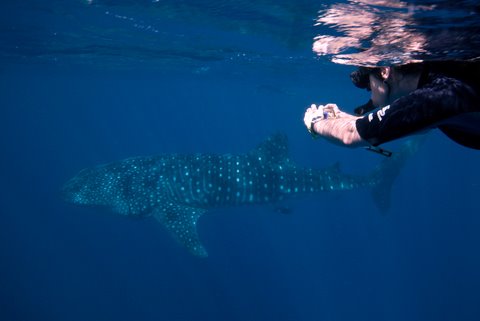 Today was the first day we split into two groups. One team went back out onto the water in search of whale sharks again and the other headed to the lab to learn the photo ID processing work. It was a pretty exciting day for both in the end! The whale shark team had a nice clear day with excellent visibility and saw a few whale sharks - one of at least 8-9metres. There was also a bit of action with a humpback whale breaching which was pretty amazing. They came back with plenty of photo ID shots from the whale sharks for the day and they will be able to process them when it's their turn in the lab tomorrow.
Today was the first day we split into two groups. One team went back out onto the water in search of whale sharks again and the other headed to the lab to learn the photo ID processing work. It was a pretty exciting day for both in the end! The whale shark team had a nice clear day with excellent visibility and saw a few whale sharks - one of at least 8-9metres. There was also a bit of action with a humpback whale breaching which was pretty amazing. They came back with plenty of photo ID shots from the whale sharks for the day and they will be able to process them when it's their turn in the lab tomorrow.The other team for today hit the lab and learnt how to process and upload the photo ID images of whale sharks. The idea is to take the best possible photo you can from preferrably the left side of the whale shark, just behind it's fifth gill. A certain patch of dots around this surrounding area can be put through a mathematical algorithm to identify it's sequence and positioning, much like they do with stars. Once the best images have been selected, they are then cropped to this particular area. A triangle is created between three starting points and all the best and most distinct spots on the whale shark within this area are selected. The selected spots are then scanned into a database of nearly 5,000 other images of whale sharks and hopefully there is a match! Our first image we processed came up with a match from a whale shark that had been seen at Ningaloo Reef every year since 2004 but had not been seen at all this season. It's last sighting was in 2008, so it was a great start to the day.
Both teams came back to the house happy and satisfied with the days learnings and discoveries and tomorrow will swap places and do it again.
Caroline




No comments:
Post a Comment